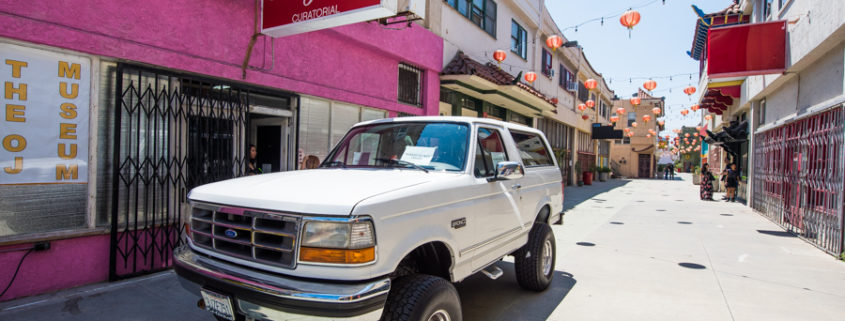O.J. Simpson Museum Review
Chinatown’s Coagula Curatorial Gallery in Los Angeles has a new pop-up O.J. Simpson Museum, which features a plethora of pop culture memorabilia about the ‘Trial of the Century’ and all things O.J. Simpson. In this post, I’ll offer some thoughts from our visit to the O.J. Museum.
Like many children of the 90s, the O.J. Simpson trial was the first major news story that I remember in vivid detail (second if you count the assault on Nancy Kerrigan). I can recall hearing Tom Brokaw’s coverage of the slow-speed Bronco chase, and I remember watching the trial unfold for months afterwards, with every detail fixated upon by the media. I was transfixed by the coverage, and it occurring during the formative years of my youth likely played a big part in my continued fascination with the trial and its significance.
While I was cognizant that there was a race component at play in the trial, my understanding of this was only surface-level and probably colored in large part by growing up in a homogenous, Midwestern farming community. It was not until decades later–last year, in fact–when the probing O.J.: Made in America and American Crime Story: the People vs. O.J. Simpson were released that I truly began to understand the multifarious issues at play beneath the surface in the Trial of the Century. Unfortunately, the O.J. Museum is more like a child’s understanding of this trial than it is a probing look…
This is not to say that the O.J. Museum is awful or was not worth seeing. There are a ton of pieces of memorabilia that I had never seen, and implicit in many of them are the topics of race and our collective fixation with his trial. To an extent, the O.J. Simpson trial was like a microcosm of mid-1990s pop culture, and some of that is evident here (even in graphic design).
Over 80 souvenir t-shirts line an entire wall, with about a 50/50 mix of guilty versus not guilty designs represented. Another room highlights magazine and newspapers featuring O.J. Photos of Nicole Brown Simpson and her friend Ron Goldman occupy another wall.
A few pieces of fan art and interesting paintings are probably the highlight, along with board games, POGS, shot glasses, and other unique pieces.
The problem is, all of these items are presented at face value. None of the underlying subtext is fleshed out, and it’s impossible to glean from the items, themselves. Unless you bring secondary meaning with you, any inclinations about race, class, media consumption, etc. are unlikely.
If you haven’t watched O.J.: Made in America or read The Run of His Life, there’s a decent chance you don’t have the background knowledge necessary to read between the lines on some of these pieces. (Side note: if you haven’t seen O.J.: Made in America, you should make a point of seeing it regardless of your interest in Simpson–it’s one of the best documentaries ever made.)
Perhaps the curator’s assumption is that only those with an especially keen fascination in O.J. Simpson and his (alleged) double homicide are going to be drawn to this museum, and such exposition is superfluous.
I’d disagree with that assessment, particularly given the renewed public interest in O.J. (The recent negative reaction to Simpson’s parole demonstrates to me that most people don’t have anything beyond a surface-level understanding of the topic.)
As controversial as the notion might be, an exceptional museum could be made about O.J. Simpson, the Trial of the Century, and its residual impact on society.
This is not that museum. In fact, I would not categorize this as a museum at all–it was more like O.J. Simpson Trial: The Tribute.
This might seem like harsh criticism of a temporary exhibit (its run ends August 22) that is more or less a passion project of the venue’s curator. I suppose that’s (maybe?) a fair point, but that’s what it is. Being a collector or enthusiast in a particular topic does not make you a museum curator.
By failing to provide context for this so-called O.J. Museum, the topic is not being done proper justice. As other, more thought-provoking takes on O.J. have demonstrated, there is a lot to unpack. All of that is, at best, coincidental to this exhibit. Instead, what you’ll encounter here is a look at an amateur collector’s shrine of O.J. Simpson eBay finds, presented in a manner that’s roughly equivalent to how they might be displayed in someone’s basement. Don’t waste your time or money.
If you’re planning a trip, check out our Ultimate Guide to Los Angeles or our California category of posts. For even more things to do, The Best Things to Do in Los Angeles: 1001 Ideas is an exceptional resource, which is written by other locals. If you enjoyed this post, help spread the word by sharing it via social media. Thanks for reading!
Your Thoughts
Have you visited the O.J. Museum in Chinatown? If so, what did you think of the experience? Would you visit an actual museum that offered a deep dive into the trial and its implications, or does the topic not sit well with you? Any questions? Hearing feedback about your experiences is both interesting to us and helpful to other readers, so please share your thoughts below in the comments!
















Leave a Reply
Want to join the discussion?Feel free to contribute!